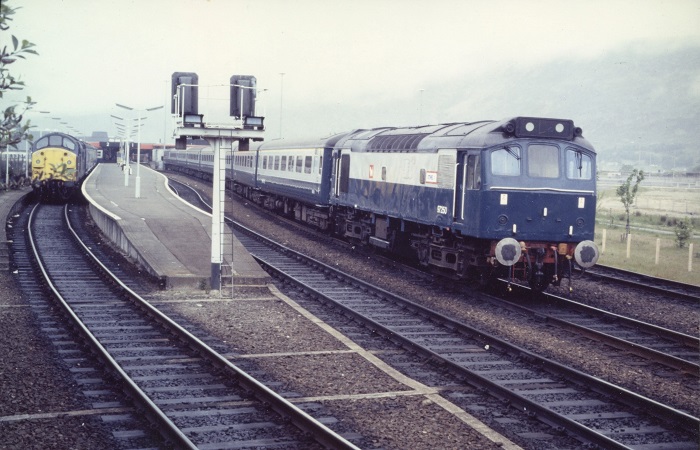
June 8th 1985 finds an overcast Fort William hosting an un-identified Class 37 and ex-Class 25 No. 97250, aka 'ETHEL 1', complete with the reason for its existance, the fully air-conditioned, electrically heated stock which, as yet, the Class 37s could not supply electrically.
| New Number | Original Number | Withdrawn | Last Depot | Date converted | 97250 | 25310 | October 1982 | Cricklewood | June 1983 | 97251 | 25305 | July 1983 | Bescot | August 1983 | 97252 | 25314 | March 1983 | Cricklewood | October 1983 |
When the LMR started using Mk3 sleepers on their services, it included those inter-regional workings that crossed into the Scottish Region, which was not a problem until the trains conveying the sleepers used routes that were not electrified and could not accomodate ETH equipped Class 47s due to their route availability. Principally this involved the sleeper service to Fort William, which in the early 1980's was in the hands of Eastfield's steam heat equipped Class 37s.
One remote option was to use the recently displaced Edinburgh - Glasgow Class 27/2s. However these locomotives were mechanically challenged after their years of gruelling service on the high speed Edinburgh - Glasgow shuttle. A number had already suffered serious fires and the separate Deutz engine/generator set used to power the coaches electrical needs would be inadequate for the heavier demands of the Mk3 sleepers. The option finally chosen was to equip a batch of Class 37s with electric train heating equipment. This however could not be accomplished overnight so a short term solution was taken in the conversion of a number of withdrawn Class 25s to operate as mobile ETH sources, relatively intact as a locomotive but unable to move under its own power.
Crewe began releasing the first ETH equipped Class 37/4s for the Scottish Region, with 37401 (ex-37268) going to Eastfield in late June 1985. By the summer of 1986 enough Class 37/4s had reached the Scottish Region to allow authorities to discontinue the use of the ETHELs.
However the growing proliferation of steam specials on and run by BR brought further use for the ETHELs, with their ability to provide power/heating for rolling stock, none of the steam locomotives being able to supply such to the coaches. Thus in the autumn of 1986 they headed south for further use. Complaints from rail enthusiasts about the aesthetic appeal of using the ETHELs or Class 47s tucked in behind the steam locomotive to provide heating led to Mk. 1 BSK No.35469 being converted to an ETH generator vehicle. On conversion the coach was not renumbered.
Late in 1991 consideration was given to using the ETHELs by InterCity on overnight sleeper services with no-heat Class 37s. The final decision was to use heater vans, leaving the ETHELs out of service at Millburn Yard, Inverness.
By 1992 the continued existance of the ETHELs was in doubt, all were still at Inverness for storage, with little hope of further use. They were removed to MC Metals in August 1994 and quickly broken up by the end of the month. As with several other long condemned locomotives that were found unfit to travel by rail so the road haulage industry now added intact scrap locomotives to their manifests. At least 97250 reached Glasgow in this embarrassing fashion.
![]()
97250 (25310)
The withdrawal on October 11th 1982 of 25310 (CW) at Tyseley with bogie damage should have been recorded as just one more casualty, especially as it had run for eight years since its last classified repair. However late in December it journeyed to Aberdeen Ferryhill where the local staff would adapt the first of three Class 25's to permit the operation of electrically heated/air conditioned rolling stock. It gained the acronym 'ETHEL 1'. 97250 was still at Aberdeen as 1982 closed.
During February 1983 25318 moved from Toton to Glasgow Works though initially setting off in the wrong direction, towards Swindon! Whether it was being considered as a candidate for a second ETHEL unit or simply as a Christmas Tree for Glasgow Works is not known. By the beginning of June 97250 was in use at Inverness, duties including pre-heating the Royal Train stock. July also possibly saw the first mobile outings for 97250 when it was attached to the 09.05 (Sunday only) Edinburgh - Oban and 15.30 return. The first working was on July 3rd using an E&G push/pull set of coaches powered by 37051 with the former Type 2 marshaled behind the Class 37.
June 1984 saw 97250 make the long trip south to Swindon Works for replacement of its main generator and bogies. With Swindon working on several Class 27's, including recently arrived 27040 and collision damaged Class 37's the variety seen here was remarkable for a Works under threat of closure. Also arriving at Swindon in late June/early July were over twenty Class 25's for stripping and scrapping. 97250 remained at Swindon until October
April 13th 1985 a Railfair held at Perth proved very popular, amongst the more glamorous exhibits was 97250. The well attended RailFair at Haymarket on August 24/25th included 97250 powering a rake of MkIII vehicles.
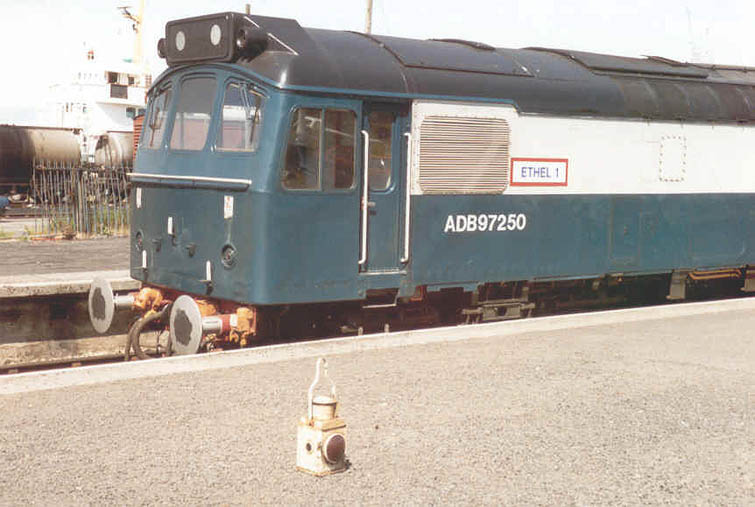
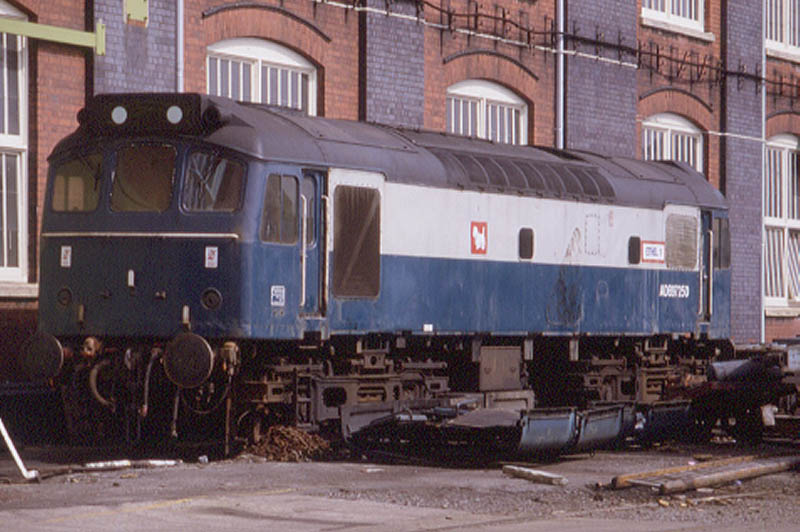

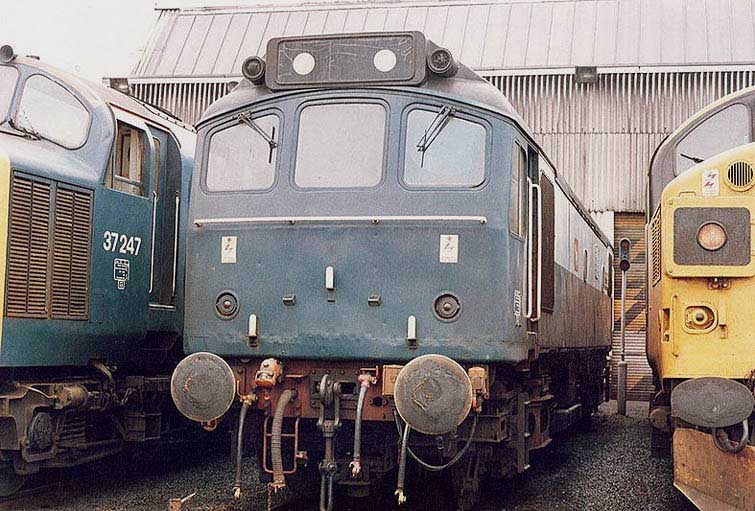
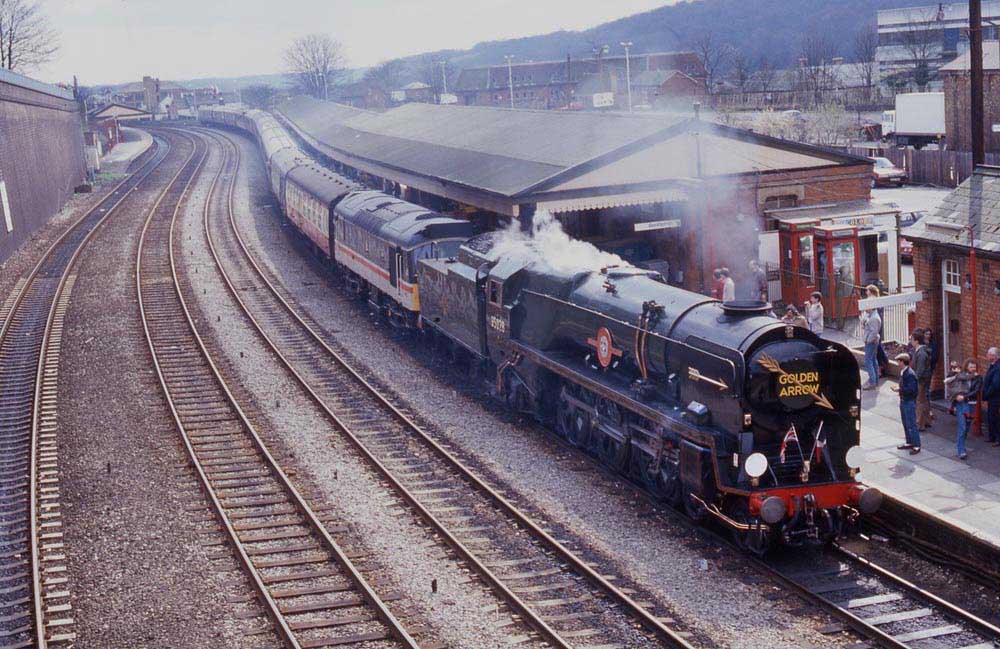
One cabside number panel from 97250 was saved from scrapping.
![]()
97251 (25305)
April 1981 had seen 25305 withdrawn for the first time, along with 25246 they were taken to Swindon Works and remarkably were placed in serviceable storage status, in Swindon's North Yard. It is possible that an enquiry from London Transport for three Class 25s may have explained this, although nothing materialised from this enquiry. 25305 was given a second lease on life in the summer of 1982 when it was revived at Swindon using parts from sister machine 25246, finally leaving the Works on September 15th, 1982, its new home being Bescot.
This second lease on life was brief, during July 1983 it was again withdrawn from service. However it quickly headed north to Aberdeen having been selected as the second 'Ethel' The initial choice had been 25319, which had spent three months withdrawn at Crewe, along with 25314, prior to both moving to Derby Works for generator & bogie work. However as with many Class 25s reaching Derby Works for minor repairs, other more serious repairs were revealed, the stringent costs limits set on repairs to this Class usually led to their withdrawal as the only option, as happened to 25319.
1983
September 18th 1983: 37108 & 97251 at Edinburgh Waverley on West Highland Tours charter round trip to Oban (Class 37 also reported as 37081?).
October 3rd 1983: 37191 & 97251 work the very first revenue trip for Mk3 sleepers, the 05.50 to Glasgow Queen Street - Fort William, ex-Euston sleeper.
October 13th 1983: 97251 at Fort William attached to sleeper stock.
October 17th 1983: 37022 & 97251 at Fort William with overnight sleeper to Euston.
October 18th 1983: 37012 & 97251 work the 1B07 06.00 Glasgow Queen Street to Mallaig.
October 28th 1983: 37184 & 97251 work the 05.50 Glasgow Queen Street - Fort William.
1984
May 5th 1984: 97251 on the West Highland, but stopped at a station with the train locomotive detached.
May 8th 1984: 37081 & 97251 noted passing Ardlui with passenger service.

June 30th 1984: 97251 stabled at Eastfield.
July 9th 1984: at Fort William with passenger stock.
July 28th 1984: 37 184 & 97251 with Fort William - Glasgow service.
August 5th 1984: 37178 & 97251 at Eastfield.
October 13th 1984: 97251 at Eastfield.
November 14th, 17th & 18th 1984: 97251 stabled at Eastfield.
1985
January 5th 1985: 97251 at Fort William with sleeper stock.
February 9th 1985: 97251 at Fort William with previous days' overnight sleeper from Euston.
February 16th 1985: 37051 & 97251 1B16 12.20 Mallaig - Fort William; two coaches with 97251 on the rear, boiler on 37051 not operational.
April 8th 1985: 37051 & 97251 with previous night's Euston - Fort William sleeper.
May 11th 1985: 97251 at Fort William with a service for Glasgow Queen Street.
June 21st & 29th 1985: 97251 stabled at Eastfield, possibly with a No.1 cab broken center window, boarded up with plywood.
July 14th 1985: 37111 & 97251 working an evening Fort William to Glasgow Queen Street service.
July 15th 1985: 37043 & 97251 at Bridge of Orchy with a West Highland service.
July 16th 1985: 37011 & 97251 working the 15.50 Mallaig to Glasgow Queen Street.
July 27th 1985: 97251 stabled at Eastfield.
August 2nd 1985: 37011 & 97251 work the 1B07 06.00 Glasgow Queen Street - Mallaig (ex-Euston sleeper).
August 7th 1985: 37011 & 97251 Fort William - London Euston.
August 9th 1985: 37033 & 97251 with previous days' 21.05 Euston - Fort William.
October 21st 1985: 97251 stabled at Perth.
1986
In late January 1986, whilst operating in the Grangemouth area 25279 suffered a broken driver's window and was sent to Eastfield for repair.
Eastfield had no Class 25 windows in stock, however it was suggested 97251 could provide a replacement, which was duly fitted (the Ethels had been superseded by Class 37/4s in October 1985). On January 29th 1986 25279 was allocated to the first part of Eastfield turn 507, which involved some empty coaching stock movements between Glasgow Queen St and Cowlairs, including the movement of the 13.00 ex-Oban stock from Queen Street to Cowlairs. However in replacing the window the Eastfield fitters had not cleaned off the two years of filth and grime, leaving the crew to do battle with this task.
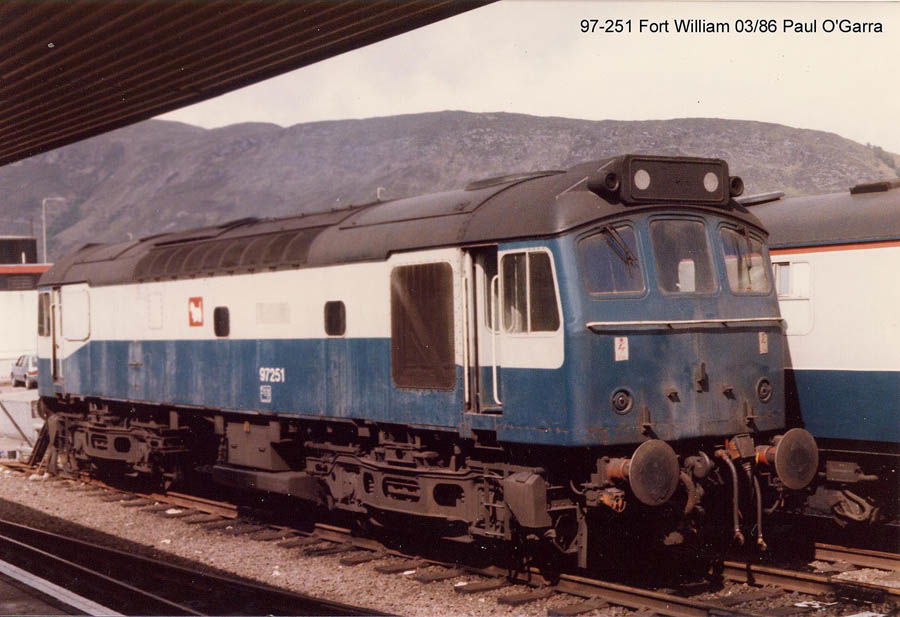
June 2nd 1986: 97251 was stabled at Perth.
June 10th 1986: 97251 stabled at Perth with three coaches.
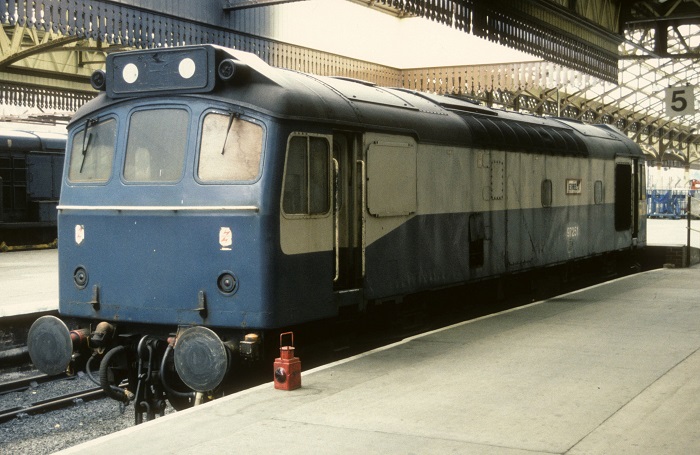
June 25th 1986: 97251 stabled in a bay platform at Perth.
July 4th 1986: 97251 stabled in a bay platform at Perth.
August 22nd 1986: all three Ethels were stabled at Eastfield.
1987
January 3rd 1987: 97251 at Eastfield.
February 7th 1987: 97251 & 6201 worked the 'Pennine Limited" from Leeds for the S&C, reported as the first use of an ETHEL in support of a steam charter.
March 14th 1987: 97251 supported 6201 over the Settle & Carlisle, heavy work being made of the run to Leeds.
April 19th 1987 Carlisle host to 97251.
May 12th 1987 D200/40122 worked an officer's special from Carlisle to Skipton and return with 97251 attached for heating purposes.
September 19th 1987: 40122 & 97251 at Carlisle, awaiting arrival Pathfinder Tours 'Son o' Skirl' tour for Mallaig, 40122 worked the tour as far as Mossend Yard.
1988
DATE UNCERTAIN: 97251 fully repainted ex-works intercity livery at Upperby Maintenance depot.
February 27th 1988: 4472 & 97251 on 'Lancastrian' charter Carnforth - Paddington, seen at Altofts & Sheffield Midland, 97251 in very fresh Inter-City livery.
March 6th 1988: at Old Oak Common, very freshly painted (Inter-City livery), no mesh screens on cab windows.
April 2nd 1988, 97251 at Fort William, mesh screens fitted over cab windows.
April 19th 1988: 97251 at Fort William with dedicated West Highland stock.
September 13th 1988: 97251 at Fort William depot.
November 12th 1988: 48151 & 97251 'Cumbrian Mountain Express' charter.
1989
February 14th 1989: 35028 & 97251 with a Crewe - Holyhead special to promote steam workings along the North Wales coast.
August 12th 1989: 97251 & 97252 at Upperby Maintenance Depot, Carlisle, both have good paintwork (repainted recently?).

November 25th 1989: 5407 & 97251 'The Cumbrian Mountain Express' Euston - Carlisle charter.
December 12th 1989 97251 with 5407 on the S&C.
July 23rd 1990: 97251 stabled Tyne Yard depot, was there for a week or so.
December 17th 1990: 71000 & 97251 with 5T30 10.00 Carnforth Steamtown - Crewe Heritage Centre two coach empty coaching stock.
1991 - 1994
Easter & May 1991: noted at Carnforth in shabby condition.
November 3rd 1991: at Inverness.
July 1992: at Inverness.
October 20th 1992: 97251 was noted at Kyle of Lochalsh.
November 3rd 1992: 37196 & 97251 on 5Z40 14.15 Inverness - Aberdeen (seven coaches).
November 8th 1992: 97251 with 26037 & 26006 on 1Z50 08.34 Edinburgh - Aberdeen, returned south with 60009, celebrating 125th anniversary of the Joint station at Aberdeen.
March 23rd 1994: still present at Invernss.
May 26th 1994: still present at Inverness.
In the December 2003 Sheffield Railwayana Auctions a builders plate for 25305 sold for GBP750.00. One cab of ETHEL 2 was resued from MC Metals, Glasgow, initially finding a new home in the garden of the purchaser.
![]()
97252 (25314)
On June 23rd 1983 Crewe depot sent withdrawn 25314/319 to Derby Works. They had been out of service for about three months and were received at Derby for generator and bogie work prior to their moving to Aberdeen to join ADB 97250 as generator vehicles. 25314 would become ADB 97252 but 25319 would not leave Derby as intended, eventually being scrapped at Swindon in December 1985. It would be replaced by 25305.
By the end of September 1983 25314 had reached Aberdeen Ferryhill, with work already underway on its conversion to ETHEL III.
With its days in Scotland numbered, 97252 made the long trek south for pastures new, travelling from Eastfield on September 25th to Carlisle, then on October 22nd in a Carlisle - Dover freight, being detached at Willesden for transfer to Marylebone, arriving there on 24th.
On March 9th 1987 25051 was moved from Carlisle, via Crewe & Bescot to Vic Berry's Leicester for scrapping, however its bogies were to be returned to BR for reuse under Marylebone based 97252. New bogies were not the only attention that 97252 received in March. By 21st 97252 had received a new coat of paint, now in InterCity livery supporting 4472 on a Marylebone - Sheffield and return excursion.
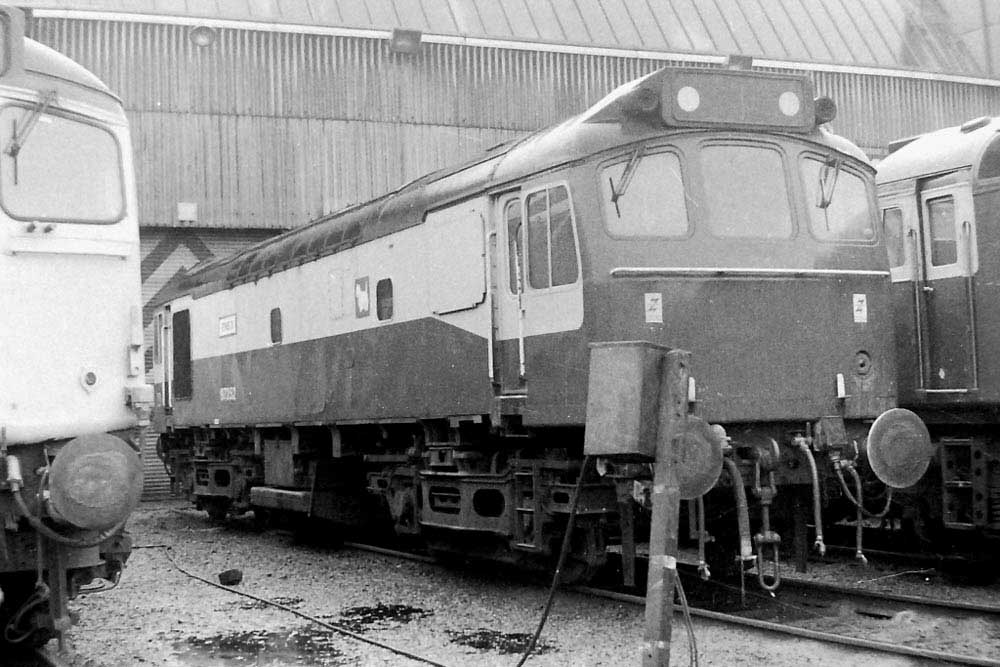
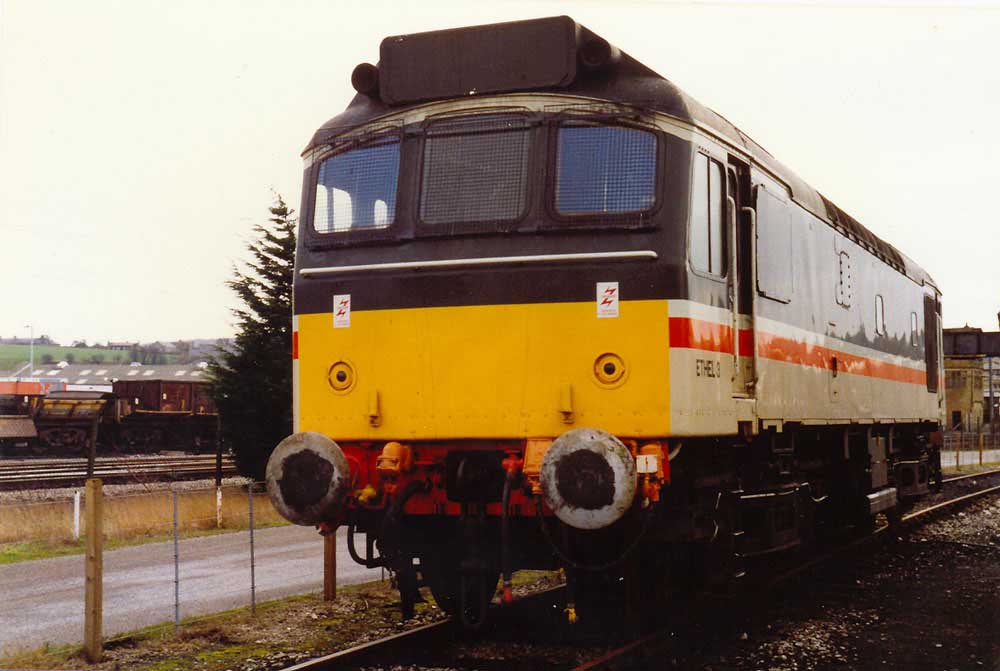
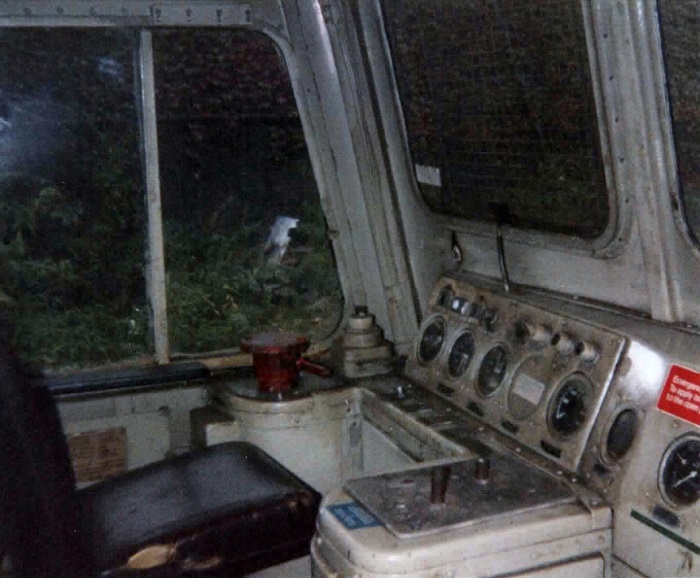
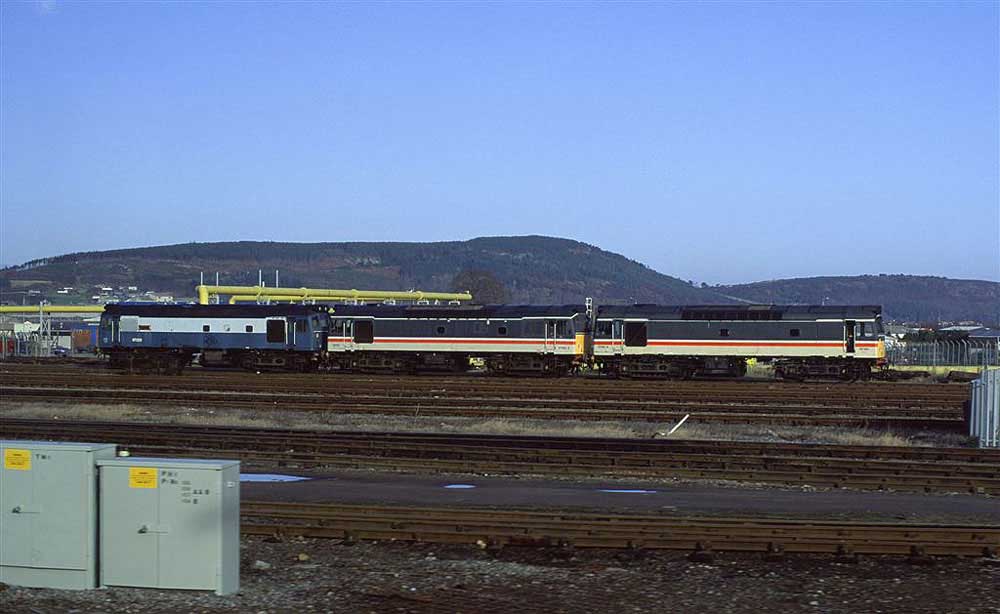
Robb Watts writes:
I was just reading your article on the old ETHEL Class 25 locomotives. I was a shunter at Inverness depot in the 90s and moved the locos on their last trip from Millburn Yard before they went for scrap. One of them had a seized brake that went unnoticed and actually caused a small fire on the trackside in the yard, I had to get the extinguisher out of the 08 to put it out!
If I remember correctly there were air leaks everywhere on them, not surprising as they had remained at the back of the yard for so long. I would imagine I was also the last BR employee to be in the cabs while they were still on BR metals.
The same also applied to the old Class 101 DTCL Driving motor coach that was uses as the observation saloon. It was painted green/white with, if I remember correctly the name Hebridean. The inside was littered with rocks and stones and smashed glass from all the windows that had been put through by vandals while it was in store. I can remember assisting that on to the low loader.
![]()
Some thoughts from Steve Palmano:
My understanding is that beyond removal of the traction motors, only minimum modification work was done. And that the engines, when providing ETH power, operated at a constant mid-range speed. That was probably achieved by having a set pressure in the engine speed control pipe via a magnet valve. Possibly the load regulator was rejigged to act as a voltage regulator. But if the engine speed was chosen as that at which the generator produced the desired voltage with a typical or maximum train heating load, then perhaps normal load regulator action was enough to keep the voltage from swinging too much.
Possibly switching on and off of the ETH would be done from the leading locomotive via the 'Blue Star' MU jumper. But whether non-ETH locomotives, as would have been used, were wired to do this I do not know. Perhaps the switching on and off was done on the Ethel itself – that would be consistent with minimum change.
Given that the Ethels required a working air compressor, perhaps the main reservoir MU hose was connected to the leading locomotive, allowing it to access the Ethel compressor.
Power and brake controls on the Ethel would need to be deactivated, although an emergency brake application valve might have been fitted, perhaps as a statutory requirement for any vehicle that might carry riders in service. Likely the exhausters were switched out, although if any vacuum braked trains were hauled, having then switched in (from the MU trainwire) for faster release would have been possible. But that would go against the minimum change idea.
Somewhere there is probably a BR document that details the changes, but finding that could be mission impossible. An institutional paper for just three units seems unlikely, and a search on the IET database does not bring up anything.
![]()
97251 0525 flk
Page updated May 26th 2025.